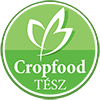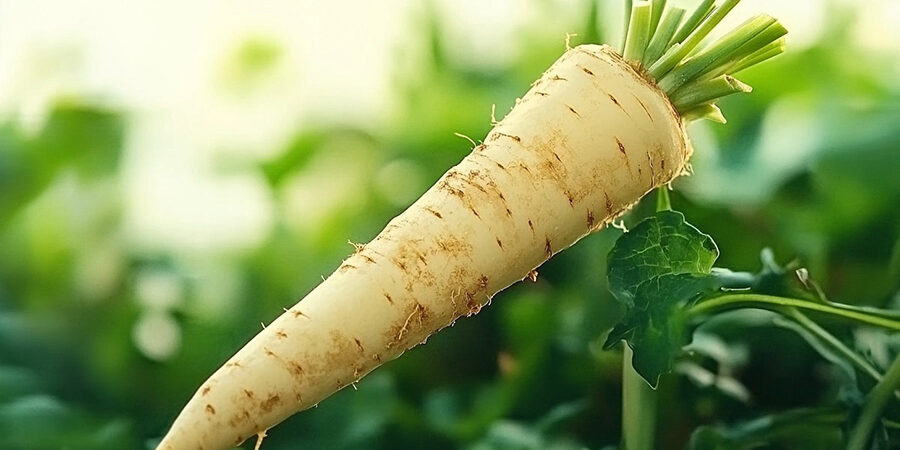With the support of our stable Hungarian producer base, this vegetable is always available in high quality in our wholesale assortment – ask us for an offer!
Horseradish (Armoracia rusticana) is a root vegetable with a strong flavour that has been consumed in Europe for centuries. It is typically grated, preserved in vinegar and served as a savoury accompaniment to meat dishes. The speciality of horseradish is its mustard oil glycosides, which react with enzymes when grated to develop an intense pungent flavour and aroma. Horseradish is popular not only for its gastronomic but also for its medicinal properties – it was used by the ancient Greeks and Romans for its digestive and respiratory cleansing properties.
From a health point of view, horseradish is known as a natural antibiotic because it contains compounds with antimicrobial activity. It is also rich in vitamin C, aids digestion, increases appetite and is beneficial for respiratory diseases. Horseradish is also economically important in certain European countries, particularly in Eastern and Central Europe, where it is traditionally grown and processed.
Specificities of horseradish production
Horseradish is mainly an outdoor plant that tolerates cooler climates well, making it an excellent crop in central and eastern Europe. It has a long growing season: harvested in the autumn, from late September to November, after spring planting. This season is the best time to buy fresh horseradish.
The largest horseradish producing countries in Europe:
- Hungary
- Germany
- Poland
- Romania
In Hungary, the horseradish grown in the Hajdúság region, including the Debrecen area, is particularly famous and is a protected geographical indication (Hajdúsági horseradish). This region produces a high-quality, aromatic, sharp-tasting horseradish that is in demand not only in Hungary but also on international markets.
Domestic horseradish is available in the autumn months, mainly from October to December, in the form of fresh roots, while the processed, pickled, grated version is available all year round. Imported products are also available from spring to autumn, typically from Germany or Poland.
How to choose good quality horseradish?
When buying fresh horseradish, you should pay attention to the following points:
- The root should be firm to the touch, not soft or spongy.
- The skin should be smooth, crack-free and light brown in colour.
- Avoid very curved, branched specimens as they are more difficult to clean and grate.
- Excessively dried or mouldy specimens should not be purchased.
The scent of good quality horseradish only becomes really intense when it is cut or grated – until then it has only a slight, earthy smell.
How to use horseradish in the kitchen?
Horseradish is extremely versatile. Its most famous use is in the form of grated horseradish, which is flavoured with vinegar, salt or sugar and stored in a jar. Horseradish prepared in this way is ideal:
- For ham, cooked meat, smoked meat
- For cold dishes, sandwiches
- For egg dishes, horseradish custards
- Mixed with pickled beetroot (horseradish beetroot), a particularly popular Easter dish
It can also be used in soups and sauces, and even in mashed potatoes for a fantastic flavour. In some regions, it is also used to make horseradish mayonnaise or creamy horseradish cream, which makes a great sauce for fish or grilled meats.
How do we store horseradish?
Fresh horseradish can keep for several weeks if stored properly:
- Stored in the fridge, wrapped in a damp tea towel or in a plastic bag, it stays fresh for up to 3-4 weeks.
- You can freeze it, but it may lose its aroma after grating.
- When grated and preserved in vinegar, it has a long shelf life – in this form, it is also available in shops all year round.
It is important not to let it dry out, as it will harden and lose its flavour.
Interesting facts about horseradish
- The pungency of horseradish irritates the mucous membranes of the nose, not the taste buds – that’s why it makes you tear easily.
- In English, the name “horseradish” is probably a mistranslation of the German “Meerrettich”.
- In the Middle Ages it was also considered an aphrodisiac.
- Horseradish root was not only used for food, but also as a medicinal herb – for example, as a poultice for rheumatic complaints.
- Horseradish leaves are also edible, although rarely used – they have a piquant flavour and can be mixed raw into salads.
Tips for using horseradish in the kitchen
- It is always a good idea to grate horseradish when it is fresh, as the flavours dissipate quickly.
- If you find it too spicy, you can tame the taste by mixing it with a little sour cream or mayonnaise.
- Wear gloves when shaving and work in a well-ventilated area.
- By adding lemon juice, you can preserve the white colour of freshly grated horseradish.
- Do not cook for long periods as it will lose its pungency – it is best added fresh or at the end of cooking.
Horseradish is not only part of our tradition, it is also one of the unique and distinctive ingredients of European gastronomy, which can bring a new colour to our everyday dishes. Feel free to try it in different forms!


